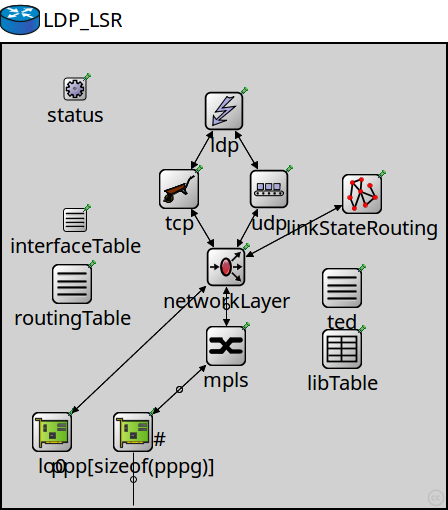 This documentation is released under the Creative Commons license
This documentation is released under the Creative Commons licenseAn LDP-capable router.
LDP Capable Routers are the main building blocks for an LDP MPLS network.

The following diagram shows usage relationships between types. Unresolved types are missing from the diagram.

The following diagram shows inheritance relationships for this type. Unresolved types are missing from the diagram.

| Name | Type | Description |
|---|---|---|
| LDPTEST | network | (no description) |
| Name | Type | Default value | Description |
|---|---|---|---|
| hasStatus | bool | false | |
| holdTime | double | 15s | |
| helloInterval | double | 5s | |
| peers | string | ||
| routerId | string | "auto" | |
| tcpType | string | firstAvailable("TCP","TCP_lwIP","TCP_NSC") |
tcp implementation (e.g. TCP, TCP_lwIP, TCP_NSC) or TCPSpoof |
| Name | Value | Description |
|---|---|---|
| networkNode | ||
| labels | node | |
| display | i=abstract/router |
| Name | Direction | Size | Description |
|---|---|---|---|
| pppg [ ] | inout |
| Name | Type | Default value | Description |
|---|---|---|---|
| status.initialStatus | string | "UP" |
TODO @signal, @statistic |
| interfaceTable.displayAddresses | bool | false |
whether to display IP addresses on links |
| routingTable.interfaceTableModule | string |
The path to the InterfaceTable module |
|
| routingTable.netmaskRoutes | string | "*" |
maintain netmask routes for interfaces |
| routingTable.multicastForwarding | bool | false |
turns multicast forwarding on/off |
| routingTable.useAdminDist | bool | false |
Use Cisco like administrative distances |
| routingTable.routingFile | string | "" |
routing table file name |
| ldp.interfaceTableModule | string |
The path to the InterfaceTable module |
|
| ldp.routingTableModule | string | ||
| ldp.libTableModule | string | ||
| ldp.tedModule | string | ||
| ldp.dataTransferMode | string | "bytecount" |
TCP data transfer mode |
| ted.interfaceTableModule | string |
The path to the InterfaceTable module |
|
| ted.routingTableModule | string | ||
| linkStateRouting.interfaceTableModule | string |
The path to the InterfaceTable module |
|
| linkStateRouting.routingTableModule | string | ||
| linkStateRouting.tedModule | string | ||
| networkLayer.configurator.interfaceTableModule | string |
The path to the InterfaceTable module |
|
| networkLayer.configurator.networkConfiguratorModule | string | "configurator" |
TODO: eventually rename to networkConfigurator |
| networkLayer.configurator.configureRoutingTable | bool | true |
add routing entries to routing table (uses the configurator module) |
| networkLayer.ip.interfaceTableModule | string |
The path to the InterfaceTable module |
|
| networkLayer.ip.routingTableModule | string | ||
| networkLayer.ip.arpModule | string | ||
| networkLayer.ip.icmpModule | string | ||
| networkLayer.ip.procDelay | double | 0s | |
| networkLayer.ip.timeToLive | int | 32 | |
| networkLayer.ip.multicastTimeToLive | int | 32 | |
| networkLayer.ip.fragmentTimeout | double | 60s | |
| networkLayer.ip.forceBroadcast | bool | false | |
| networkLayer.icmp.interfaceTableModule | string |
The path to the InterfaceTable module |
|
| networkLayer.icmp.routingTableModule | string | ||
| lo0.lo.interfaceTableModule | string |
The path to the InterfaceTable module |
|
| lo0.lo.mtu | int | 4470B | |
| mpls.interfaceTableModule | string |
The path to the InterfaceTable module |
|
| mpls.libTableModule | string | ||
| libTable.config | xml | xml(" |
table contents to be loaded on startup |
// // An LDP-capable router. // // LDP Capable Routers are the main building blocks for an LDP MPLS network. // module LDP_LSR { parameters: @networkNode(); @labels(node); @display("i=abstract/router"); bool hasStatus = default(false); double holdTime @unit("s") = default(15s); double helloInterval @unit("s") = default(5s); string peers; string routerId = default("auto"); string tcpType = default(firstAvailable("TCP","TCP_lwIP","TCP_NSC")); // tcp implementation (e.g. ~TCP, ~TCP_lwIP, ~TCP_NSC) or ~TCPSpoof *.interfaceTableModule = default(absPath(".interfaceTable")); *.routingTableModule = default(absPath(".routingTable")); *.tedModule = default(absPath(".ted")); *.libTableModule = default(absPath(".libTable")); gates: inout pppg[] @labels(PPPFrame-conn); submodules: status: NodeStatus if hasStatus { @display("p=73,45"); } interfaceTable: InterfaceTable { parameters: @display("p=73,176;is=s"); } routingTable: IPv4RoutingTable { parameters: forwarding = true; routerId = routerId; @display("p=70,240"); } ldp: LDP { parameters: holdTime = holdTime; helloInterval = helloInterval; @display("p=222,67"); } ted: TED { parameters: @display("p=340,244"); } linkStateRouting: LinkStateRouting { parameters: peers = peers; @display("p=360,150"); } tcp: <tcpType> like ITCP { parameters: @display("p=177,145"); } udp: <default(firstAvailable("UDP"))> like IUDP { parameters: @display("p=267,145"); } networkLayer: IPv4NetworkLayer { parameters: @display("p=224,223"); gates: ifIn[sizeof(pppg)+1]; ifOut[sizeof(pppg)+1]; } lo0: LoopbackInterface { @display("p=50,388"); } ppp[sizeof(pppg)]: <default("PPPInterface")> like IWiredNic { parameters: @display("p=131,388,row,90;q=l2queue"); } mpls: MPLS { parameters: //peers = peers, classifierModule = "^.ldp"; @display("p=224,302"); gates: netwIn[sizeof(pppg)+1]; netwOut[sizeof(pppg)+1]; ifIn[sizeof(pppg)+1]; ifOut[sizeof(pppg)+1]; } libTable: LIBTable { parameters: @display("p=340,305"); } connections allowunconnected: linkStateRouting.ipOut --> networkLayer.transportIn++; linkStateRouting.ipIn <-- networkLayer.transportOut++; ldp.tcpIn <-- tcp.appOut++; ldp.tcpOut --> tcp.appIn++; ldp.udpOut --> udp.appIn++; ldp.udpIn <-- udp.appOut++; udp.ipOut --> networkLayer.transportIn++; udp.ipIn <-- networkLayer.transportOut++; tcp.ipOut --> networkLayer.transportIn++; tcp.ipIn <-- networkLayer.transportOut++; lo0.upperLayerOut --> networkLayer.ifIn[0]; networkLayer.ifOut[0] --> lo0.upperLayerIn; for i=0..sizeof(pppg)-1 { pppg[i] <--> ppp[i].phys; ppp[i].upperLayerOut --> mpls.ifIn[i+1]; ppp[i].upperLayerIn <-- mpls.ifOut[i+1]; mpls.netwOut[i+1] --> networkLayer.ifIn[i+1]; mpls.netwIn[i+1] <-- networkLayer.ifOut[i+1]; } }